Top Guide to UPVC vs Wooden Windows: Key Comparisons in 2025
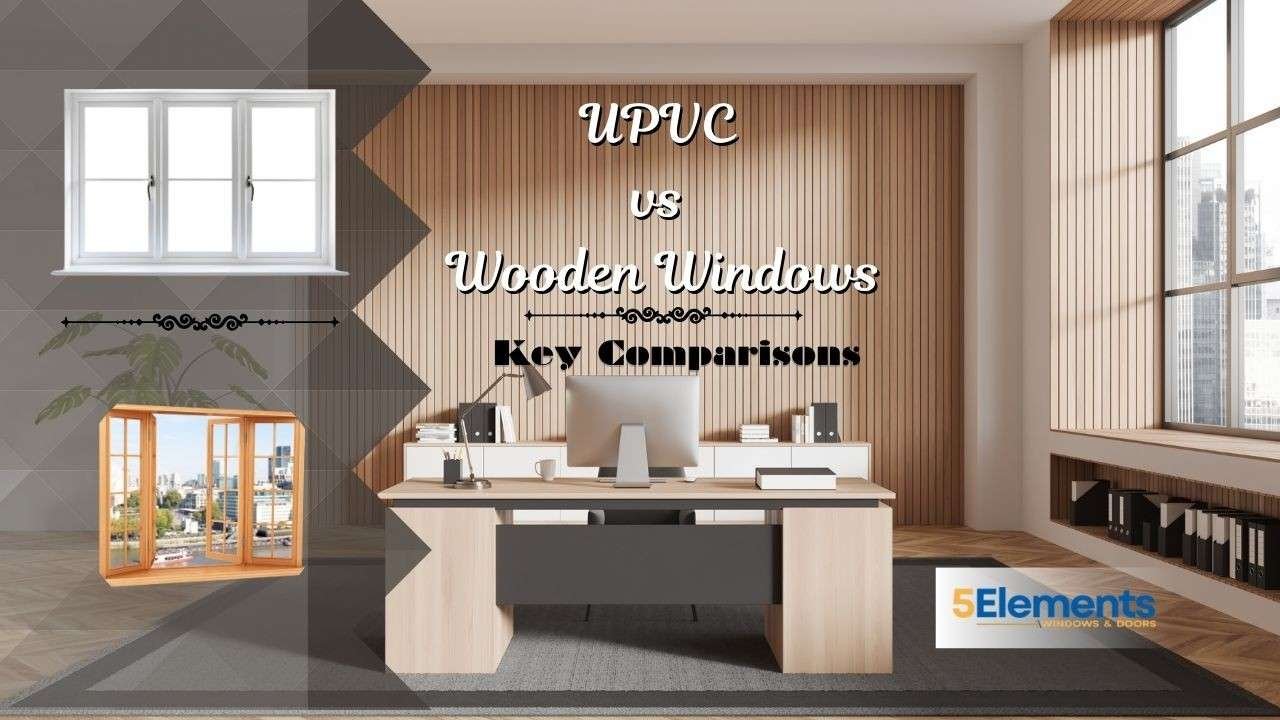
UPVC vs wooden windows requires a cautious evaluation of their advantages as well as disadvantages. Windows plays an important role in any domestic situation, influencing ventilation, lighting, and average consolation. While the UPVC windows Kerala offer a fantastic resistance to weather situations and require a minimum maintenance, wood windows provide a classic allure that complements the architectural attraction of a domestic. The desire for UPVC (Unplasticized Polyvinyl Chloride) and wooden domestic windows isn’t always unusual for owners and builders alike. While UPVC home windows are for their durability, low safety, and affordability, wood domestic windows are prized for their natural splendor, insulation houses, and undying attraction.
Making the proper selection consists of considering elements such as charge, balance, the protection requirements, overall performance of electricity, and environmental results.
What is UPVC Windows?
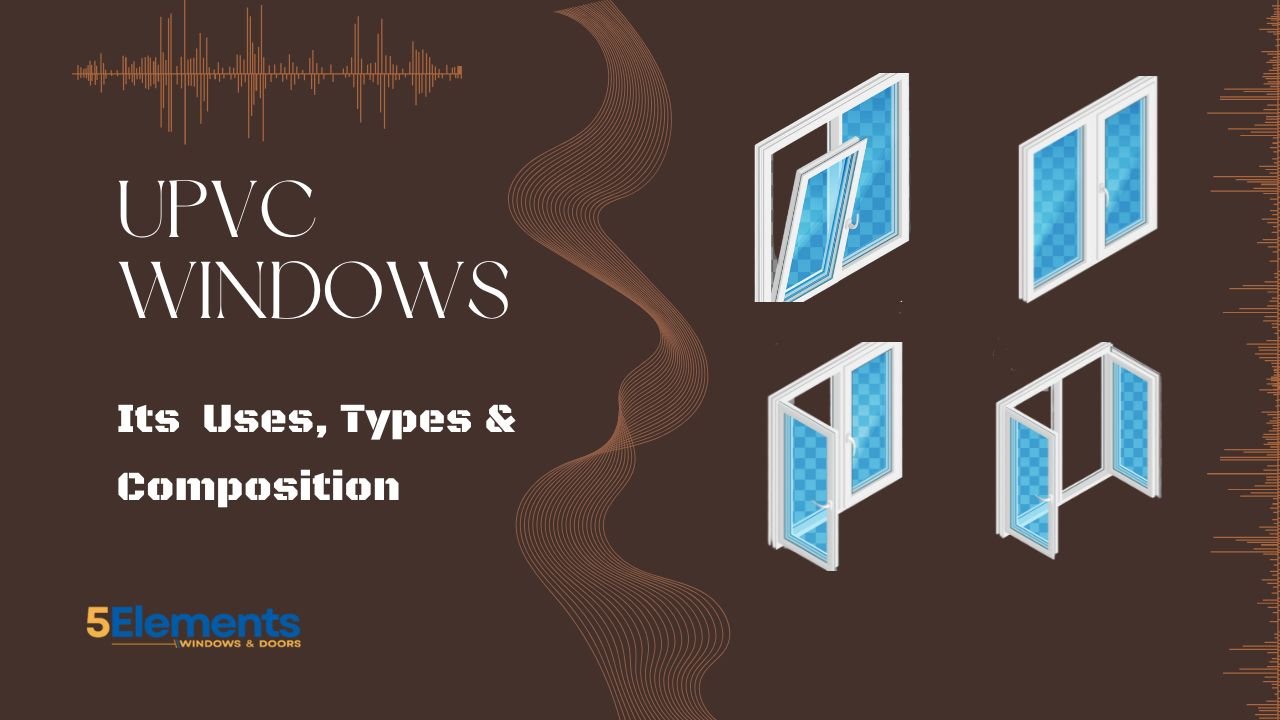
UPVC (Unplasticized Polyvinyl Chloride) home windows are a famous window format made from a rigid, durable, and climate-resistant shape of plastic. Unlike the traditional Polyvinyl Chloride PVC plastic, UPVC no longer consists of plasticizers, which makes it stronger, stronger, and longer-lasting. These UPVC vs wooden windows is relevant in current scenario and are widely applied in residential and business homes because of their low preservation, energy required, widespread common overall performance, protection, and affordability. The Manufacturing Process of UPVC windows are artificial through an extrusion method wherein molten UPVC is molded into profiles. These profiles are bolstered with galvanized steel to enhance strength and anxiety. Afterward, they will be shriveled and assembled into window frames, incorporating double or triple glazing for advanced insulation and protection.
Unplasticized Polyvinyl Chloride is normally used for domestic windows and doors because of its superb durability, safety, and charge effectiveness in the topic UPVC vs wooden windows. Distinct from wooden, which calls for ordinary portrayal and sealing, or metallic, which is vulnerable to rust as well as corrosion, UPVC is particularly powerful in competition to the moisture, termites, and excessive weather conditions, making it beneficial for prolonged-term use. Its high thermal insulation allows it to keep indoor temperatures, lessen strength intake, and reduce heating and cooling costs. Additionally, UPVC doors and windows design are lightweight but sturdy, offering greater appropriate safety with multi-factor locking structures. Their versatility in layout, color alternatives, and finishes, collectively with timber-like textures, makes them suitable for various architectural patterns. Furthermore, UPVC is environmentally pleasant, as many current UPVC merchandise are recyclable. These mixed blessings make UPVC a favored desire for owners and developers seeking out low-cost, long-lasting, and power-green window and door answers.
Common Uses and Popular Designs
UPVC windows-doors are widely applied in modern homes, apartments, and enterprise houses due to their performance and affordability in the comparison UPVC vs wooden windows. They offer incredible insulation, weather resistance, and low preservation, making them a desired choice for plenty of residence proprietors. Some of the most well-known designs encompass the following:
1. Casement Windows:
Hinged on one side, those domestic home windows open outward like a door, permitting the most appropriate airflow and unobstructed views. They are easy to feature, provide wonderful insulation, and are best for areas requiring advanced airflow, along with kitchens and dwelling rooms.
2. Sliding Windows:
Featuring horizontally shifting panels that go smoothly with the flow on tracks, sliding windows are best for areas with restrained regions. They offer a current-day, smooth look and are smooth to perform, making them best for balconies, patios, and modern-fashion homes. Additionally, they provide sufficient natural light and are identified for their area-saving design.
3. Tilt and Turn Windows:
These flexible home windows can open inward like a casement window for optimum airflow or tilt from the pinnacle for controlled airflow and added safety. Their dual capability makes them noticeably practical for houses requiring clean cleaning and efficient airflow, making them a splendid choice for bedrooms and immoderate upward-push houses.
4. Bay Windows:
Extending outward from the wall, bay home windows create an extra interior space and beautify the herbal lights. They upload architectural characters to a home, imparting a comfortable corner for seating or decoration. Bay home windows are frequently discovered in dwelling rooms or ingesting regions, making spaces feel larger and more open and even improving the aesthetic concept of the property.
What Are Wooden Windows?
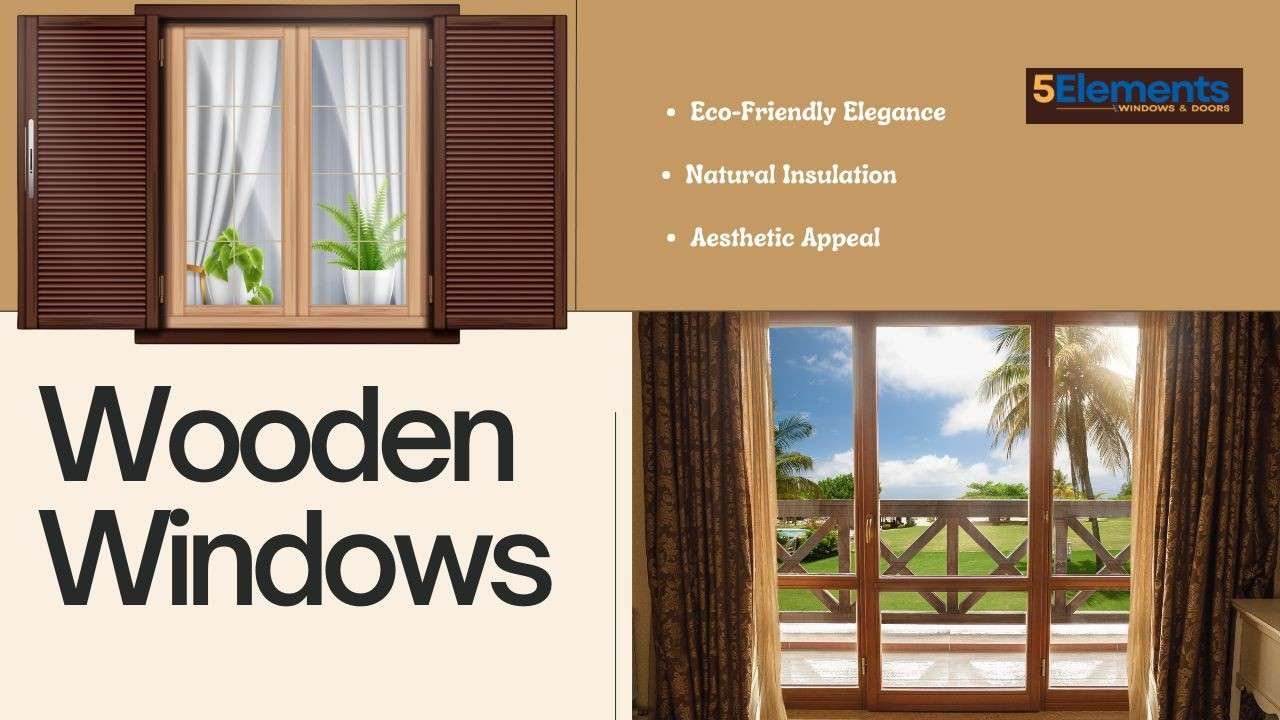
In UPVC vs wooden windows, Wooden windows are traditional frames of windows made from wood, presenting a conventional aesthetic, sturdiness, and insulation benefits. They are implemented in houses for their undying appeal and capability to be custom-designed homes. Wooden home windows are designed from numerous kinds of timber, together with oak, pine, mahogany, or teak, each supplying particular tiers of durability, grain texture, and resistance to climate conditions. In addition to their beauty, wooden windows offer awesome thermal insulation, guide indoor temperatures, and reduce electricity fare. They moreover contribute to noise reductions and the development of quieter and more comfortable living environments. Also, timber is a sustainable and inexperienced material that is sourced responsibly, making it a desired preference for environmentally conscious proprietors. With proper preservation, together with sealing and painting, wooden home windows can face diverse climate conditions and stay for many years while preserving their beauty and functionality.
Benefits of Using Wooden Windows
• Natural Insulation:
Wood is an amazing insulator, supporting the preservation of houses that are warm in wintry weather and funky in the summertime with the useful resource of the decreasing warmness transfer. This herbal thermal common overall performance can decrease strength bills by means of minimizing the need for excessive heating and cooling. Additionally, timber domestic home windows reduce noise, creating a quieter indoor surroundings.
• Aesthetic Appeal:
Wooden windows offer a traditional, excessive-prevent appearance that complements the splendor of any home, adding warm temperature and splendor. Their natural grain patterns and rich textures create an undying appeal that complements every traditional and cutting-edge architectural fashion. Over time, wood domestic home windows amplify a unique patina, further improving their personality and appeal.
• Customizable:
Wood may be painted, stained, or carved to match any architectural fashion, allowing house proprietors to gain their favored aesthetic. Whether opting for a swish present-day cease or a difficult antique layout, wooden windows may be tailor-made to the wholesome modern updated characteristic possibilities. Additionally, they’ll be refinished or repainted over the years to conform to changing décor tendencies or non-public tastes.
UPVC vs Wooden Windows: Key Comparisons
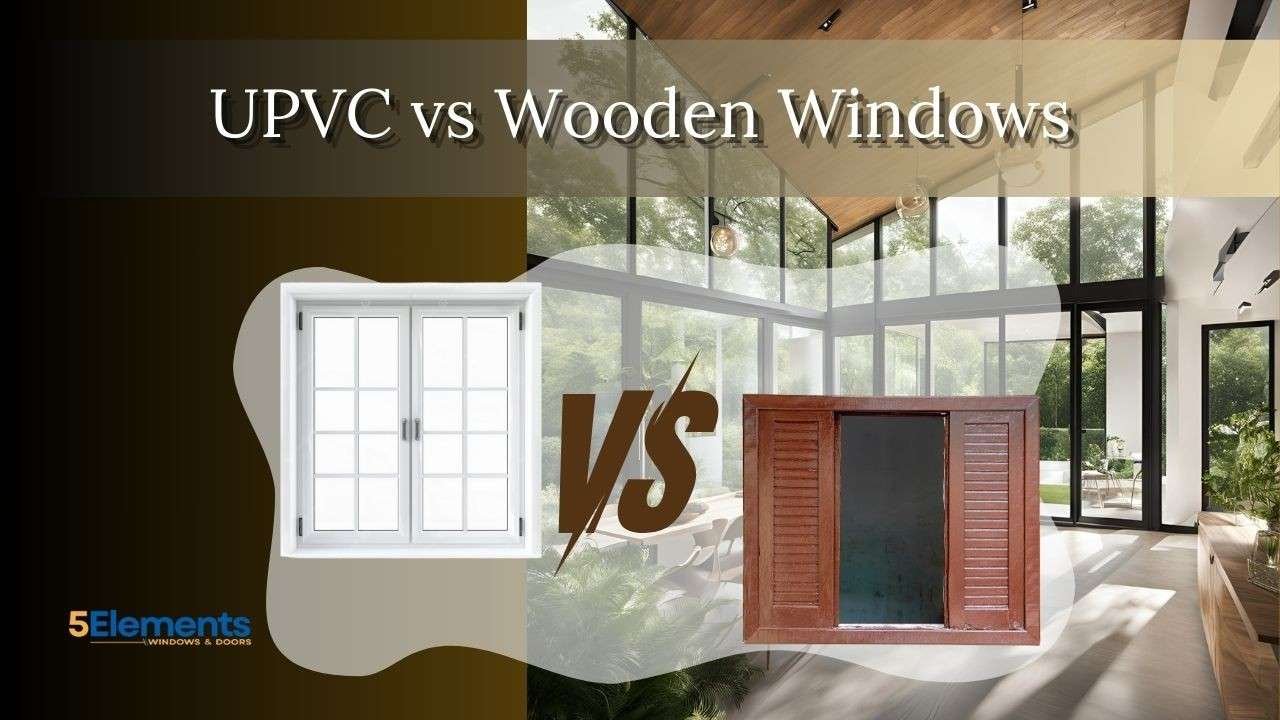
1. Aesthetic Appeal
- UPVC: Offers a cutting-edge, smooth appearance with loads of colorings and finishes, along with wooden grain textures to mimic real wood. Out of UPVC vs wooden windows, UPVC windows offers a high-quality choice for the present-day houses, flats, and office areas. However, it lacks the genuine and warm temperature and depth of herbal timber, and a few architectural styles might not be healthful in their artificial look. Over time, the surface can also fade or lose its shine, but repainting is normally no longer a choice for UPVC.
- Wooden: In UPVC vs wooden windows, wooden window provides timeless splendor, wealthy textures, and the new customization alternatives that enhance each present-day and traditional house. Wooden home windows may be painted, stained, or carved to create complex designs, permitting house owners to suit them with historic, vintage, or costly styles. Additionally, real timber gives a herbal grain sample, making each window unique. Over time, well-maintained timber domestic fit uPVC windows increase an adorable patina that attracts and enhances sophistication for any asset.
2. Durability
- UPVC: UPVC windows colour paint out of UPVC vs wooden windows, are highly durable and proof in opposition to the moisture, termites, and decay, making it best for regions with excessive humidity, heavy rainfall, or coastal climates. It no longer warps, cracks, or increases due to the temperature fluctuations, making sure lengthy-time period balance. With a lifespan of 20–30 years, UPVC home windows continue to be practical with minimal protection. However, publicity to robust sunlight hours through the years may cause a few discolorations, and brittle plastic can end up prone to cracking in rather cold temperatures.
- Wooden: If nicely maintained, timber domestic home windows can last over 50 years, now and then, even exceeding a century in historical buildings. However, they’re liable to environmental damage, which incorporates warping, swelling, cracking, and pest infestations like termites and fungi. Wooden frames require defensive coatings to resist moisture harm and sun publicity. Despite those challenges, better hardwood alternatives consisting of teak and mahogany provide superior durability compared to softwoods like pine.
3. Energy Efficiency
- UPVC: It features great insulation houses, successfully decreasing warm temperature loss and reducing power bills. Its multi-chambered layout and hermetic seals offer superior thermal performance, retaining houses warm in wintry weather and funky inside in the summertime. Additionally, UPVC windows save the condensation production, which can also lessen the threat of mold growth and enhance indoor air quality. Double or triple glazing can, in addition, beautify energy savings.
- Wooden: Naturally insulating due to its low thermal conductivity, it assists in holding indoor temperatures and decorating electricity performance. Properly sealed and dealt with wooden domestic home windows prevent drafts and restrict the warmth transfer. In UPVC vs wooden windows, wooden windows, if the wood isn’t maintained well, gaps and cracks can also boom, decreasing its insulation ability. With top-notch finishes and present-day updated weatherproofing techniques, timber home windows can carry out further UPVC in terms of energy efficiency.
4. Maintenance
- UPVC: It requires minimal maintenance and services, the best desiring occasional cleaning with soap and water to hold it even as searching for new. It now does not want to portray, seal, or sharpen. However, as quickly as UPVC is broken or discolored, it can’t be repaired or repainted without issue, requiring an entire substitute in a few instances. At the same time, it is proof against corrosion vs rust and extended exposure to intense weather situations.
- Wooden: UPVC vs wooden windows shows wooden windows require ordinary portray, sealing, and polishing to defend it from moisture, ultraviolet rays, and insect infestations. Failure to keep timber home windows can bring about rotting, cracking, or warping. However, wooden home windows can be refinished, repaired, and restored in a couple of examples, allowing owners to update their look or make their lifespan larger. Proper care includes reapplying shielding coatings every few years, especially in harsh climates.
5. Security
- UPVC: Often strengthened with multi-point locking systems, steel reinforcements, and effect-resistant glazing, making them notably steady. The energy of UPVC windows affords a resistance to pressured entry, making them an amazing choice for urban and excessive-security areas. However, lower-exceptional UPVC frames might also weaken over time, and excessive pressure can cause structural harm.
- Wooden: Naturally strong and strong; however, its protection depends on the kind of timber and the exceptional of creation. Hardwoods, like all right teak, offer fantastic power, but at the same time, softwoods may be extra liable to harm. Over time, timber windows may also weaken due to environmental publicity, making them more prone to interrupt-ins if no longer strengthened. Adding present-day locks, metallic reinforcements, and also laminated glass can enhance their security level.
6. Cost
- UPVC: More low priced upfront and price-effective in the long run due to the minimal maintenance and lengthy-lasting durability. The low initial funding makes UPVC an approximate price range-pleasant alternative for house owners looking for a trouble-loose window answer. Additionally, UPVC windows provide lengthy-time period savings via the strength efficiency, decreasing heating and cooling charges over the years. However, they may not upload a whole lot of cost to assets as compared to high-quit timber windows.
- Wooden: Higher preliminary investment due to the cost of materials, craftsmanship, and customization. Maintenance fees, along with repainting and sealing, add to the general lifetime value. However, wooden home windows can extensively beautify an belongings’ value, mainly in ancient or luxury homes. Their longevity, aesthetic enchantment, and ability to be refinished a couple of times lead them to protracted-term of funding despite the better protection prices.
7. Customization Options
- UPVC: Available in various pre-made colors, wood-impact finishes, and textures. Some producers provide laminates or foil coatings to imitate herbal wooden grain.
- Wooden: In UPVC vs wooden windows, wooden window offers a truly unlimited customization. Homeowners can paint, stain, or carve wooden frames to suit one-of-a-type aesthetics. Unlike UPVC, domestic wooden windows can be repainted more than once, allowing owners to replace their tradtional unique appearance. Custom carvings and detailing are also feasible, making wooden home windows the best for the history and duration of houses.
8. Noise Insulation
- UPVC: Provides remarkable noise reduction, mainly when paired with double or triple glazing. Due to its hermetic construction, UPVC frames block external sounds, making it a high-quality choice for urban environments or homes close to highways and airports. The multi-chambered layout in UPVC profiles that fully complements its soundproofing skills.
- Wooden: Naturally dense, wooden windows provide extremely good noise insulation. However, if they increase gaps or cracks over time due to weather publicity, their main speciality of soundproofing competencies may decrease. Regular upkeep, which includes sealing and repainting, enables the maintenance of their noise-blocking houses. For the most useful acoustic performance, timber home windows must be paired with first-rate glazing.
9. Resale Value
• UPVC: Increases a home’s resale fee by providing a contemporary, strength-green, and coffee-preservation choice. However, in luxurious homes or length residences, UPVC won’t be the desired choice because it lacks the premium aesthetic of wood. Over time, shade fading or put on might also lessen its enchantment.
• Wooden: Enhances property price, particularly in historical, high-stop, or traditional houses. Wooden windows are frequently visible as a top-class feature, adding appeal and scale-back enchantment. Buyers seeking out authenticity and sturdiness desire wood windows over UPVC. Well-maintained wood windows can significantly increase the marketplace desirability.
10. Weather Resistance
• UPVC: In UPVC vs wooden windows, UPVC is completely immune to rot, rust, and corrosion. Unlike wood, UPVC no longer increases or settles with changing temperatures. It can overcome heavy rain, snow, and humidity without warping or cracking.
• Wooden: While clearly strong, wooden calls for the right remedy to resist moisture, humidity, and severe weather situations. It can expand or settle with temperature changes, doubtlessly inflicting warping or gaps. Regular sealing, painting, or staining complements weather resistance and forestalls deterioration.
11. Weight and Ease of Installation
• UPVC: Significantly lighter than wood, making it simpler and faster to put in. Its lightweight nature reduces the stress on window frames and walls, making it a desired alternative for big-scale installations or the excessive and upward-push buildings. Additionally, UPVC doors and windows frequently include pre-geared-up glazing, further simplifying installation.
• Wooden: In UPVC vs wooden windows, heavier than UPVC, requiring strong structural support. The installation manner may take longer due to specific requirements and potential customizations. However, the delivered weight presents a solid and robust sense, improving common window durability. Professionals experienced in woodworking can be wanted for correct installation.
12. Condensation Resistance
• UPVC: Out of UPVC vs wooden windows, UPVC minimizes condensation due to its non-porous nature and terrific thermal insulation houses. It prevents the accumulation of moisture on window surfaces, reducing the risk of mold and mold increase. The multi-chambered design of UPVC window frames enables maintaining indoor temperature and prevents bloodless bridging.
• Wooden: Can resist condensation if well dealt with and sealed. Also, untreated or poorly maintained wood absorbs water content, leading to swelling, mold, or rot. Regular varnishing or sealing is critical to save you water harm. Proper airflow inside the home additionally helps handle condensation on wooden windows.
13. Glazing Compatibility
• UPVC: Works seamlessly with unmarried, double, and triple glazing, offering high thermal efficiency and noise reduction. Some UPVC home windows incorporate glazing gadgets, reducing the risk of air leaks and enhancing the insulation performance with insulation materials thermal properties. The fixed body design ensures a tight seal for higher electricity efficiency.
• Wooden: Compatible with all glazing sorts, inclusive of historical past-fashion single glazing, double glazing, and superior energy-green glass. However, wooden frames might also require reinforcement for heavier glazing devices. Proper sealing is essential to hold insulation and prevent air leaks around the glass panels.
Merits and Demerits of UPVC Windows
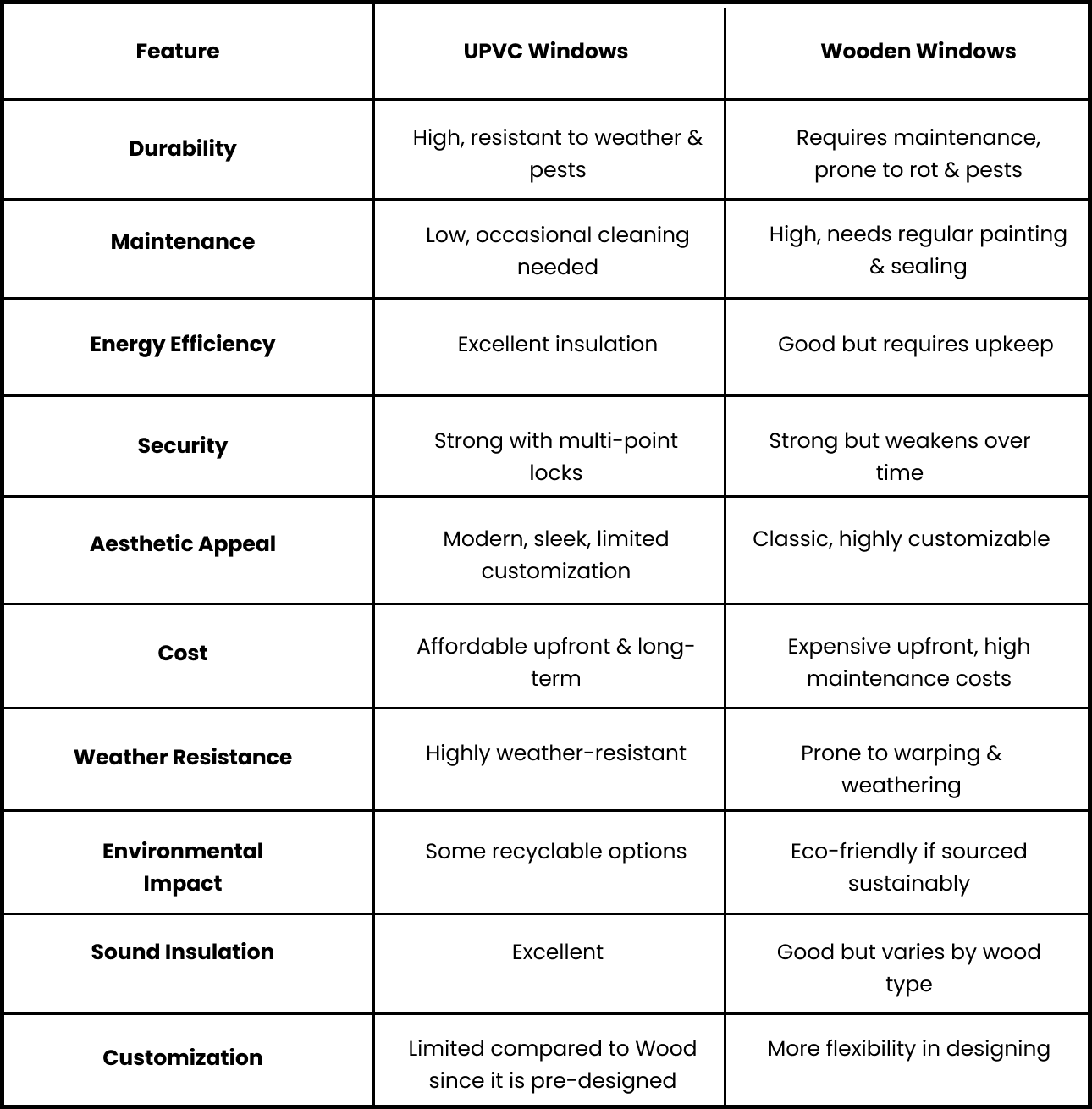
Conclusion
In UPVC vs wooden windows, both UPVC and wood windows have their benefits and downsides. When evaluating UPVC and wood windows, UPVC emerges as the advanced desire for cutting-edge homeowners and developers. Its remarkable sturdiness, with low safety necessities, and the value-effectiveness make it a sensible and prolonged-time period investment. Unlike wood home windows, which require frequent portraying, sealing, and protection in opposition to pests and moisture, UPVC domestic windows stay resilient to weather adjustments, corrosion, and placed-on. Additionally, their remarkable insulation homes contribute to the energy performance, the decreasing heating and cooling fees during the 12 months. With a wide variety of patterns, finishes, and shades available, UPVC windows offer functionality and aesthetic enchantment updations without any compromise on being pleasant. For the ones seeking a problem-unfastened, the price range-pleasant, and sustainable window solution, UPVC home windows stand as the clear winner in 2025 and beyond.
UPVC is powerful, long-lasting, and smooth to keep, making it an incredible alternative for most homeowners. Wooden windows, then again, offer unprecedented opted beauty, customization, and insulation; however, they require extra renovation.
Choosing among the two depends on your price range, aesthetic choices, weather situations, and lengthy-time period funding goals. Before you decide, cautiously weigh those elements to make certain they are a pleasant match for your house.
FAQ
1. Do UPVC windows appear as good as wooden windows?
Wooden home windows have an undying appeal and elegance that UPVC cannot fully mirror. However, modern UPVC home windows are available in woodgrain finishes, permitting proprietors to take advantage of a wood appearance with the blessings of UPVC.
2. Which is high-quality, UPVC or plywood?
When comparing UPVC and plywood, the Unplasticized Polyvinyl Chloride is usually taken into consideration as the higher choice for applications in which excessive moisture resistance is crucial, like kitchens and bathrooms, as it’s far substantially extra evidence against water damage in contrast to plywood, making it more durable in humid environments.
3. How long do uPVC home windows last?
High-quality uPVC domestic home windows have a lifespan between 10 and 35 years. So, tremendous uPVC windows can assume an average lifestyle expectancy of around two decades.
4. Do UPVC windows provide better noise insulation than wooden windows?
Yes, UPVC windows, especially for people with double or triple glazing, offer advanced noise reductions compared to wood windows. However, well-sealed wood domestic home windows can also offer proper sound insulation.
5. Which type of windows are opted for severe climate situations?
UPVC windows are opted for excessive weather situations as they no longer expand, reduce, or decay due to moisture, unlike timber windows, which can warp or crack over the years in excessive humidity or changing temperatures.